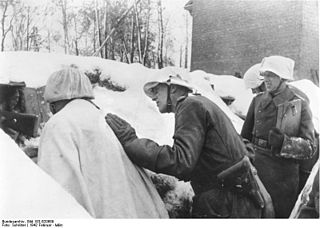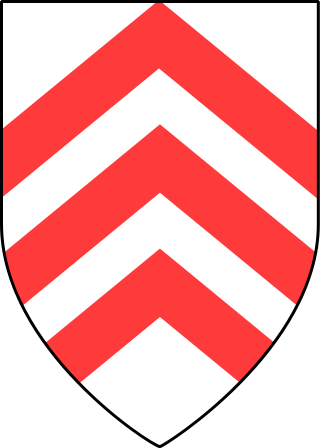
The 22nd Infantry Division, which soon became the 22nd Air Landing Division, was a specialized German infantry division in World War II. Its primary method of transportation was gliders. The division played a significant role in the development of modern day air assault operations. Towards the end of the war, the formation was reshaped into the 22nd Volksgrenadier Division.

The 61st Infantry Division was a combat division of the German Army during the Second World War. Towards the end of the war, it became the 61st Volksgrenadier Division.

The 18th Army was a World War II field army in the German Wehrmacht.

The 6th Infantry Division was a unit of the German Army during World War II.

The 46th Infantry Division was an infantry division of the German Army during World War II that fought on the Eastern Front. Towards the end of the war, it became the 46th Volksgrenadier Division.

The 26th Infantry Division was a pre-World War II German Infantry Division of the 1st mobilisation wave. It was mobilised for World War II on September 26, 1939, disbanded on September 10, 1944, near Radom and reformed as the 26th Volksgrenadier Division on September 17, 1944, near Poznań by absorption of the new 582nd Volksgrenadier Division of the 32nd mobilisation wave. Remnants of the Division entered U.S. captivity in the Harz region in 1945.
The 326th Infantry Division was the only Eastern Front veteran division to have fought in the battles of Normandy. It was formed on November 9, 1942, shortly after its return from Southern Russia to serve as an occupation force in France. On May 5, 1943, the division was transformed into a static division. The 326th Infantry Division was destroyed during the Battle of Normandy. A new 326th Volksgrenadier Division was formed on September 4, 1944, in Galanta by redesignation of the new 579th Volksgrenadier Division of the 32nd mobilisation wave. In 1945 the division, separated into two groups, entered U.S. captivity in the Ruhr Pocket and Harz respectively.

A first 277th Infantry Division was ordered to form on May 22, 1940, as part of the 10th mobilisation wave, but this order was rescinded after the French Surrender. A new 277th Infantry Division was formed in Croatia on November 17, 1943, as part of the 22nd mobilisation wave, the division was destroyed in the Battle of Normandy in August 1944. A third, 277th Volksgrenadier Division was formed on September 4, 1944, in Hungary by redesignation of the newly formed 574th Volksgrenadier Division of the 32nd mobilisation wave. In 1945 the division entered U.S. captivity in the Ruhr Pocket.
The 79th Infantry Division(79. Infanterie-Division) was an infantry division of Nazi Germany's Wehrmacht during World War II.

The 94th Infantry Division was a German Army infantry division in World War II.
In the German Wehrmacht before and during World War II, infantry divisions were raised as part of a designated Aufstellungswelle or Welle (wave), sometimes translated as "draft". The Aufstellungswelle system was adopted by the Wehrmacht in late 1938. Peacetime units were the first wave, and 34 other waves followed until the 35th wave in April 1945. Several types of divisions were organized by Aufstellungswelle, including infantry, security, shadow and Volksgrenadier divisions.
The 47th Infantry Division was an infantry division of the German Heer during World War II. It was formed in February 1944 and was destroyed by the forces of the Western Allies in the Mons cauldron in September 1944. The division was then reassembled as the 47th Volksgrenadier Division and operated until 1945.
The 217th Infantry Division was an infantry division of the German Heer during World War II. It later became the Division Group 217. It is also listed as the 217th Volksgrenadier Division.

The 211th Infantry Division was a German infantry division of the German Heer during World War II, active from 1939 to 1944.

The XXVI Army Corps was a Wehrmacht army corps during World War II. It existed from 1939 to 1945. It was also known as Corps Wodrig during the Invasion of Poland.
The 253rd Infantry Division was an infantry division of the German Heer during World War II.
The 254th Infantry Division was an infantry division of the German Heer during World War II.
The 257th Infantry Division was an infantry division of the German Army during World War II.
The 271st Infantry Division was an infantry division of the German Heer during World War II.

The 371st Infantry Division, was an infantry division of the German Army during World War II, active from 1942 to 1945 in two separate instances.











